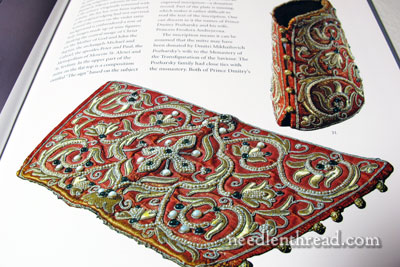Textiles, embroidery, fabric, clothing – a study of all of these in any given country’s history provides insight into the values and traditions of that have permeated a nation over the centuries.
Hand embroidery has played a significant role in the fashions, the arts, and the religious and cultural interests of most countries, in one way or another. And so, although I generally don’t get into “costuming” and the making of historical or re-creation clothing, I do love to study the records of historical fashion from different countries.

Russian Elegance: Country & City Fashion from the 15th to the Early 20th Century, written by Luisa Yefimova and Tatyana Aleshina and published by Vivays Publishing, is a remarkable, magnificent, stunning, beautiful – oh! the list can go on! – book that focuses on exactly what the title promises.
For the lover of historic clothing styles and fashion, the merits of the book will be instantly obvious. For the hand embroiderer, the attraction to a book on the history of fashion in Russia might not be as easily recognizable at first.

But wait until you open the book! Very quickly, the merits of such a book to the embroiderer become apparent!
The book is full of sumptuous examples of embroidery – from exquisitely embellished religious articles, to colorful needlework on traditional Russian peasant dresses, to exuberantly embroidered gowns, waistcoats, and accessories.

Each of the major pieces in the book is discussed in depth. The provenance of each piece is given in detail as well as a thorough description of materials and techniques, and then the whole explanation of where these pieces – their style, their construction, the materials used, and so forth – fit in the history of Russian clothing is further detailed in the text.

A couple years ago, I wrote about Larissa Borodich’s goldwork and pearl embroidery, and since then, I’ve had a fascination with needlework encrusted with pearls, precious metals and gemstones.
In Russian Elegance, you’ll find a good dose of this type of embellishment, with some fantastic close-ups of museum pieces. I found myself poring over these examples voraciously and reading everything about them. Beautiful, beautiful works of art!

Much of the beginning of the book is devoted to traditional Russian dress – the clothing worn by Russian peasants, by the middle class, and by the merchant class. Colorful, vivid clothing fill these pages! And inspiration abounds – the fabrics are flowered over with spectacular folk motifs. There are superabundant examples of embroidered shirts in vibrant color, of aprons and accessories, of trim.

Bespeckling the book, the little accessories here and there will capture the embroiderer’s interest, too.

The second part of the book moves into fashion influenced by Paris. Here, you’ll find extraordinary examples of embellished brocades and silks, of fine laces, of delicate whitework.

Hats and capes, shoes, flounces, dresses – all reflecting the highest of Parisian fashion and attesting to the skill and artistry of the Russian designers, seamstresses, embroiderers – fill the second part of the book.

The text throughout the book is interesting to read, and to help the reader keep track of the names of various articles relating to clothing, there’s an excellent glossary in the back of the book.

When I initially came across this book, I didn’t really know what to expect. I just knew that I wanted to see more of what was inside! And I wasn’t disappointed.
So, what will the hand embroiderer gain in the study of a book like Russian Elegance? I can promise you the churning of the Inspiration Wheel – the singing of the Muses – the flowering of creative thoughts! The embroidery and needlework you will see in this book is amazing! In addition, the text is interesting to read; learning about the development of clothing styles in Russia over the centuries will further enhance your appreciation for textiles, needlework, design.
